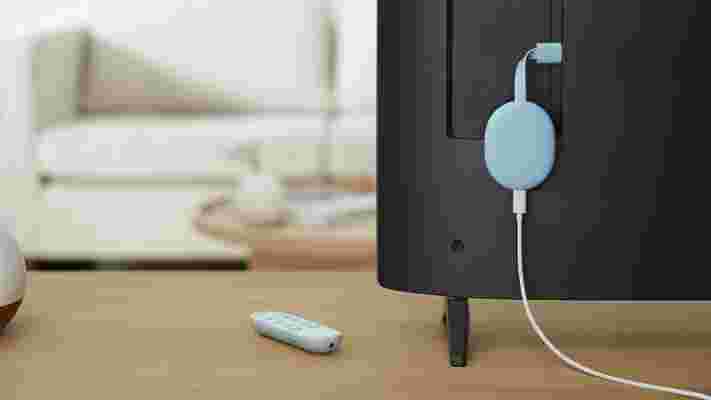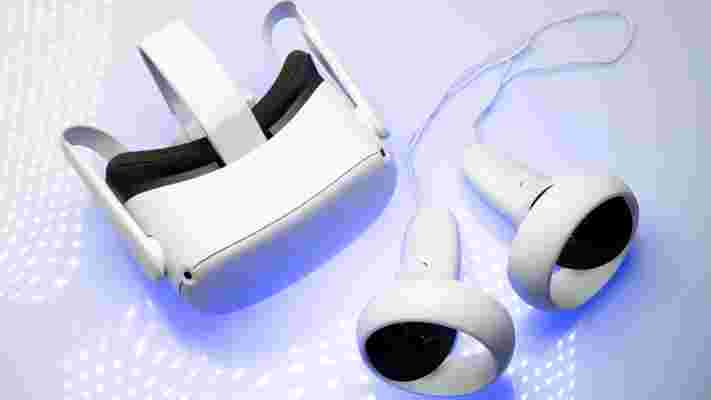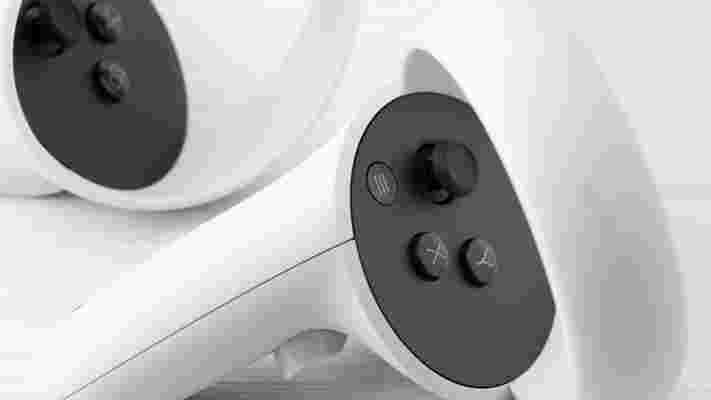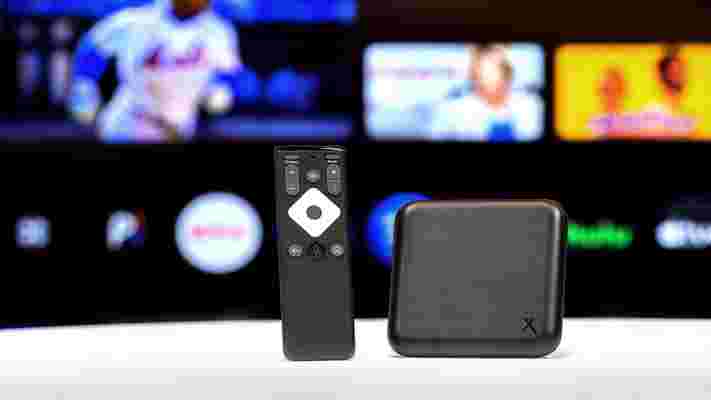You already know that your Oculus Quest 2 headset (which got a name change to Meta Quest last year) can take you on journeys into outer space, or let you enjoy a round of VR mini-golf with your friends, but there are probably a bunch of features you have no clue it has.
Here, you'll find a collection of our favorite hidden Quest 2 features that you might want to take advantage of next time that you're in VR. From tracking your fitness data, to issuing voice commands, there's almost certainly going to be something on this list you've not tried before.
See your phone notifications in VR
While many relish the serene isolation that their Quest 2 headset provides, if you’re anything like us there’s always that nagging fear that you might be missing something going on in the real world.
Thankfully, there’s a way to feel less cut-off when entering VR by turning on phone notifications so that you can be certain you won’t miss that important text message.
As long as you have an iPhone 7 or later, or any Android smartphone , you can download the Oculus app and enable this feature. Just open the app, hit Menu in the bottom right corner then go to Devices. Here you can alter your Headset Settings to turn on Phone Notifications (the option should be between Controllers and Developer Mode if it’s available).
Once you’ve followed the on-screen instructions and paired your devices you’ll be all set. Using either the phone app or the Oculus Quest 2’s settings, you can adjust the notifications you receive to limit them to certain apps and control how many you see.
If multiple people use the same Quest 2 headset, you may want to set up multiple accounts too so that you each only see your own phone notifications.
Cast what you're playing to a phone or TV
VR offers some amazing party game experiences, but with the screen only visible to one player at a time it can leave those watching from the sidelines in the dark about what their friend is going through. Thankfully, using the Oculus app you can cast what’s playing out in VR to your smartphone or Google Chromecast device.

To turn on casting while someone is in VR, start by opening up the Oculus app and pressing the symbol in the top right that looks like a headset with a signal coming out of it (it’s sandwiched between the bell and diamond icons).
Then choose which of your connected headsets you want to cast from and the device to cast to - either your phone or nearby Chromecast.
Once this is started, we recommend turning off the setting that makes headset audio play through the phone or Chromecast - this option should be visible on your phone screen. If the headset audio is turned up enough, you’ll all be able to tell what’s going on.
This is also a helpful tool for introducing new players to VR. Since you can see what they see in real-time, you can guide them through their first steps without having to guess what they’re faced with or swap the headset back and forth.
Use voice commands
That’s right, you can leave your controllers behind and navigate through the Quest 2’s menus with just the sound of your voice.
To get started you’ll first need to turn the feature on. While wearing the VR headset you can do this by either pressing the Voice Commands button in your Quick Settings panel, double-tapping the Oculus button on your right controller, or saying “Hey Facebook”.
Those familiar with Amazon Echo or Google Nest smart speakers may prefer that last method, though to use it you’ll separately need to head to your Quest 2’s Experimental Settings and enable the wake word.
Whatever way you choose to wake up the Quest 2, you can then issue various commands like “Create a party,” "Change Guardian," or “Open Beat Saber” alongside a bevy of other options you can find on the official Oculus site .
Add your couch to VR and experience 120Hz gaming
Speaking of experimental settings, the Quest 2 has a selection of other options you might want to try out
These settings are classified as ‘Experimental’ as they aren’t yet optimized for every game experience, or may not quite as polished as the Quest’s other features. That said, from our experience we haven’t noticed any major issues with them.

The two favorites we recommend you try out are the 120Hz refresh rate option and the setting to add your couch into VR.
Not all VR games will run at 120Hz , but those that do look so much better with this feature turned on - though you will also notice that your Quest 2’s battery drains quite a bit faster while playing these titles.
Adding your couch into VR creates a dedicated space that, when entered, will cause the Quest 2 to swap from room-scale to stationary VR automatically. Standing up will return you to roomscale. If you’re looking to take a quick break or swap to a new game, this is a much more convenient way to alter your boundary settings without having to rejig them manually.
Re-centre your view
This is one you might already know about, but in case you’ve forgotten, we’ve added it in here as being able to reset your view is an incredibly useful tool.
While the Quest 2 headset’s tracking is generally great, your movements can sometimes cause your position to drift a little out of place. Other times, the orientation of your play space might not quite match up with the game’s virtual play area
To fix either of these issues you can quickly reset your view and you don’t even have to leave the experience. It's easy. Just look straight forward and hold down the Oculus button on your right controller. A white circle will quickly fill up in front of you and then you’ll see the world shift around you.

Track your fitness stats
VR headsets like the Quest 2 have become a vital part of many people’s daily workout routines thanks to the great VR fitness games that are out there.
If this is true for you then to help you keep track of your fitness progress we’d recommend turning on Oculus Move . This app allows you to keep an eye on your real-time fitness data like your time spent being active in VR and roughly how many calories you’ve burned.
It won’t quite compare to the in-depth fitness data you’d get from a Fitbit or one of the best fitness trackers out there, but if you’re looking for a more casual way to track your progress then Oculus Move is the answer.
If you're looking for other new VR experiences, you might also want to check out our picks for the best Quest 2 games . With titles from Resident Evil 4 to Beat Saber, you're sure to find something you'll love playing.
As Google Chrome 100 arrives, we tried version 1.0 on Windows 11 to see how far it's come
In the mid-2000s, Google was known for announcing joke software for April Fools Day that we all knew wouldn't ever be made. So, when its new web browser , Google Chrome first arrived in September 2008, users had thought that the company had delayed the joke by a few months.
Since its arrival, Chrome has seen many changes and revamps, to the point where it's the most-used web browser in the world. It's now also been made available on smartphones and tablets , further changing how we browse the web.
Google is now about to launch version 100 , and as it's close to April 1, we wouldn't be surprised if there's a major new feature or two coming to the update, perhaps as a hint to its April Fool gags of yore, or to tie in with Google Mail's launch, which actually launched on April 1 2004 .
With this in mind, we tracked down version 1.0 of Google Chrome and tried it in Windows 11 to see how it handles modern websites... or if it is even usable.
Using Google Chrome 1.0 in 2022

The internet of 2008 was very different from what we use in 2022. It was a year when Apple's App Store launched alongside the iPhone 3G , and we were all still trying to get used to browsing the web on our smartphones.
Trying to play a 4K video on YouTube back then would have been an impossible task, and streaming Banjo Kazooie on Game Pass through Chrome would have been as likely as seeing Mario come to the Steam Deck in a sequel to Half Life.
After finding version 1.0.154 of Chrome, released on December 11 2008, we installed it and saw the familiar layout of the web browser, but in a shade of light blue that seemed to be a constant presence in these early versions. Tabs were still relatively new at the time, with Mozilla's Firefox , and Apple's Safari having had the feature for only a few years at the time.
But tabs defined Chrome, encouraging you to press the '+' button to open multiple tabs for the sites you wanted to visit.
And this is where the troubles began for us.
As the above screenshots show, loading up our Apple Studio review brought up the text, but it was the only aspect we could decipher. Chrome 1.0 couldn't render the photos or any sections correctly. Some would load up, but they would be stretched to the point that they would be pixelated. We thought we'd go to YouTube to see how this would fare, and not only did it show the mobile version, but nothing was displaying correctly anyway; only YouTube's logo.
There were other times when we would visit other sites, and we would receive a pop-up saying 'You're using an old version, please upgrade your browser.' Ignoring this would try to display the website in question regardless, but none of them worked. Ironically, searching for trees in Google was the one website that did show correctly, albeit in its mobile version.

Looking around Chrome 1.0.154's features, it's as barebones as you would expect for a web browser that was officially two months old at the time. There's a Preferences section, but nothing in the way of themes and web extensions that today's web browsers offer.
The idea of doing some work in this version of Chrome through Google Docs or Apple's Pages is impossible - this was an era of the internet where you'd be browsing the web to be rid of boredom or to find the answer to something.
While it was a short-lived trip using one of the first versions of Google Chrome, it's at least showed us how far Chrome - and the internet itself - has come.
In 2022, playing Sea of Thieves or watching the upcoming Star Wars series Obi-Wan Kenobi in 4K, is seen as a normal task in Chrome. After 100 versions and almost 14 years of Chrome, it only makes us wonder as to what version 200 could bring, and the devices we'll be browsing the web on then.
Comcast and Charter have a plan to tackle Roku
Charter Communications and Comcast are joining forces to develop a brand new streaming platform and hardware to provide 4K streaming content.
Both companies made it clear in the announcement that this is a “50/50 joint venture” with equal stakes as they each pitch in significant resources. The companies' broadband and cable businesses will not be a part of this joint venture and will remain separate.
Equal partnership
Comcast will bring in its Xfinity Flex platform and hardware, the retail side of XClass TVs (made by Hisense), and Xumo to the table. For those unaware, Xumo is an internet television service that Comcast bought back in 2020. Basically, it’s free TV online.
Charter is contributing $900 million that will trickle in over the coming years to fund the whole venture. It will also begin to offer 4K streaming devices and voice remotes next year.
The plan, as they’ve laid out, is Xfinity Flex will serve as the starting point with Xumo as the free TV option. XClass TV will be supported by both companies for better customer service as they push these TVs and their platform to the market.
The still-unnamed platform will have big services like Netflix and Hulu with Peacock appearing to be a major focus.
The companies also clarified that Xfinity Flex and Xumo will remain independent, so if you’re already a watcher of both, you won’t have to buy extra hardware.

Stiff competition
Looking at the deal, Comcast and Charter appear to be readying an aggressive strategy, and with good reason as they face a lot of stiff competition.
Roku, for example, is a behemoth of the streaming industry that consistently sees rave reviews from users and critics . In fact, it recently announced an exclusivity deal with Lionsgate to stream Nicholas Cage’s new movie when it comes out.
Other services also see the writing on the wall. Paramount is investing over $6 billion dollars into streaming in hopes of getting a piece of that pie.
Best of luck to the Comcast/Charter duo. A recent study by the Leitchtman Research Group revealed Comcast lost 407,000 thousand cable subscribers in Q3 2021. Perhaps this plan can help keep both companies afloat.